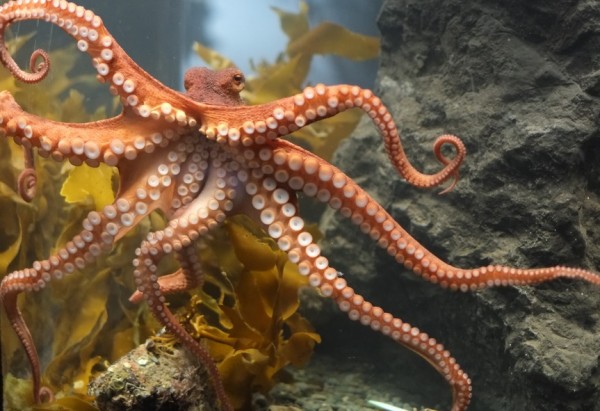Studying How Octopuses Move will Help Make 'Soft Robots'
| Ana Verayo | | Apr 17, 2015 10:56 AM EDT |
(Photo : Wikimedia) The octopus apparently moves without any rhythm.
Scientists now know how octopuses coordinate their tentacle arms when they crawl.
Using high speed cameras, a team from the Hebrew University of Jerusalem captured images of crawling octopuses on film in their attempt to find out how exactly these mysterious creatures use their ultra flexible arms and glide into movement.
Like Us on Facebook
This new study reveals how simple this movement is. It seems an octopus chooses which specific arm to use to push itself into moving. This new study is also the first detailed analysis of how these cephalopods manage to move without support from a skeleton.
Engineers are now interested in learning their secret to design and develop biologically sound robots.
People would want to explore how to build soft robots that will be highly useful in medical purposes and rescue operations, according to Guy Levy, one of the researchers of this study. He adds that soft bodied robotic arms inspired by octopuses would no longer be limited to fixed joints.
For example, this could be used for accessing narrow spaces or difficult to reach areas that can help people trapped inside a collapsed building.
Levy and colleague Benny Hichner have recorded videos of the animals to find out the secret of their remarkable movement that is both efficient and fluid. They analyzed this special motion per frame.
These new findings show each arm apparently shortens and lengthens while each arm pushes the body in a singular direction.
Levy further explains the octopus only thinks about what arm to use and not which direction it will go. He says this is the octopus' solution to a seemingly complicated problem that it just has to pick an arm that will move in any direction.
These creatures can push any of their eight legs, meaning they have the ability to crawl in any direction regardless of where their body is facing. Surprisingly, there is no rhythm or pattern to their fluid limb movements.
Further studies will involve figuring out the internal functions of the nervous system of these cephalopods to reveal how they control the coordination of their crawling.
This study was published in the journal Current Biology.
TagsSecret of How the Octopus Moves Without Tangling Revealed by Scientists, Octopus, how does the octopus moves, octopus movement arm coordination movement no rhythm, Scientists Reveal How the Octopus Moves to Make 'Soft Robots'
©2015 Chinatopix All rights reserved. Do not reproduce without permission
EDITOR'S PICKS
-

Did the Trump administration just announce plans for a trade war with ‘hostile’ China and Russia?
-

US Senate passes Taiwan travel bill slammed by China
-

As Yan Sihong’s family grieves, here are other Chinese students who went missing abroad. Some have never been found
-

Beijing blasts Western critics who ‘smear China’ with the term sharp power
-

China Envoy Seeks to Defuse Tensions With U.S. as a Trade War Brews
-

Singapore's Deputy PM Provides Bitcoin Vote of Confidence Amid China's Blanket Bans
-

China warns investors over risks in overseas virtual currency trading
-

Chinese government most trustworthy: survey
-

Kashima Antlers On Course For Back-To-Back Titles
MOST POPULAR
LATEST NEWS
Zhou Yongkang: China's Former Security Chief Sentenced to Life in Prison

China's former Chief of the Ministry of Public Security, Zhou Yongkang, has been given a life sentence after he was found guilty of abusing his office, bribery and deliberately ... Full Article
TRENDING STORY

China Pork Prices Expected to Stabilize As The Supplies Recover

Elephone P9000 Smartphone is now on Sale on Amazon India

There's a Big Chance Cliffhangers Won't Still Be Resolved When Grey's Anatomy Season 13 Returns

Supreme Court Ruled on Samsung vs Apple Dispute for Patent Infringement

Microsoft Surface Pro 5 Rumors and Release Date: What is the Latest?










